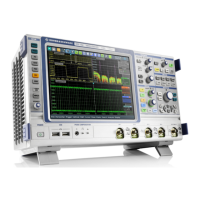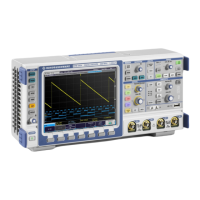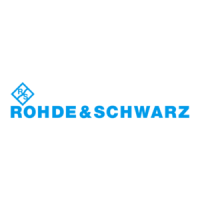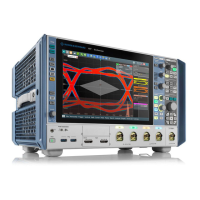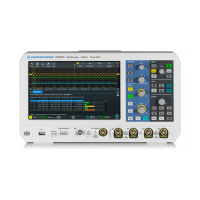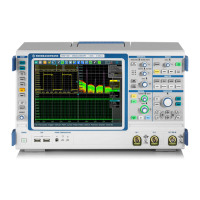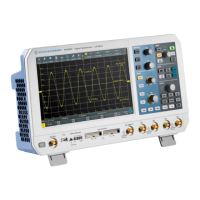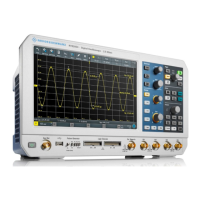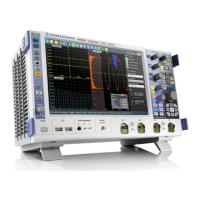Do you have a question about the Rohde & Schwarz RTA4004 and is the answer not in the manual?
Provides crucial safety guidelines for using the oscilloscope and its accessories safely.
Basic information for setting up the instrument for the first time or when changing its operating site.
Details how to access functionality via the main menu, shortcuts, and entering data using the touchscreen.
Describes the function of front panel keys grouped into logical blocks like Action and Analysis controls.
Covers connecting probes to the instrument and displaying signals, including important notices on attenuation factors.
Explains how to adjust horizontal settings, also known as timebase settings, to view waveforms in the horizontal direction.
Describes how to adjust vertical settings and probe settings for waveform display.
Details the use of various probe types, including passive, active voltage, and current probes.
Explains how the instrument captures the signal and converts it to digital samples for processing and storage.
Explains how to use front panel keys and rotary knobs to adjust trigger settings and start/stop acquisition.
Covers general trigger settings independent of trigger type, including trigger mode and trigger type.
Details the edge trigger, the most common type, which occurs when the signal passes the trigger level in a specified direction.
Magnifies parts of the waveform to view more details, applicable to analog, digital channels, and math waveforms.
Describes how to create and configure math waveforms using predefined operations and save them as equation sets.
Covers search functions to find events like edges, pulse widths, peaks, or other events matching specific conditions.
Performs automatic measurements on selected channels, displaying results directly on the waveform or in a result line.
Enables performing up to 8 different measurements simultaneously, with detailed descriptions of measurement types.
Determines results at current cursor positions, which can be set manually or follow the waveform.
Uses masks to determine signal amplitude within specified limits, detecting errors or testing compliance of digital signals.
Provides basic FFT calculation to convert time-based waveforms into spectrums for analyzing signal effects.
Offers additional functionalities to FFT calculation, including spectrogram and peak list analysis.
Provides spectrum analysis and spectrogram features, allowing frequency-dependent event analysis.
Describes saving and loading instrument configurations, including display settings, for repeating tests or analysis.
Explains how to save waveform data to USB flash drives, including history data and logic channels with MSO option.
Covers general instrument settings accessible from the setup menu, including device information, language, and probe adjustment.
Provides instructions for updating the instrument's firmware using a USB flash drive downloaded from the internet.
Explains the importance of deskewing probes for accurate power measurements and adjusting zero offset.
Describes the waveform generator's capabilities for outputting simple functions, modulated waveforms, arbitrary waveforms, and sweep waveforms.
Explains triggering mechanisms, including general settings, edge, width, pattern, runt, rise time, timeout, and actions on trigger.
Covers quick measurements and automatic measurements, including measurement types and statistics.
Lists available applications such as mask testing, FFT analysis, spectrum analysis, XY-diagrams, digital voltmeter, trigger counter, and Bode plot.
Provides crucial safety guidelines for using the oscilloscope and its accessories safely.
Basic information for setting up the instrument for the first time or when changing its operating site.
Details how to access functionality via the main menu, shortcuts, and entering data using the touchscreen.
Describes the function of front panel keys grouped into logical blocks like Action and Analysis controls.
Covers connecting probes to the instrument and displaying signals, including important notices on attenuation factors.
Explains how to adjust horizontal settings, also known as timebase settings, to view waveforms in the horizontal direction.
Describes how to adjust vertical settings and probe settings for waveform display.
Details the use of various probe types, including passive, active voltage, and current probes.
Explains how the instrument captures the signal and converts it to digital samples for processing and storage.
Explains how to use front panel keys and rotary knobs to adjust trigger settings and start/stop acquisition.
Covers general trigger settings independent of trigger type, including trigger mode and trigger type.
Details the edge trigger, the most common type, which occurs when the signal passes the trigger level in a specified direction.
Magnifies parts of the waveform to view more details, applicable to analog, digital channels, and math waveforms.
Describes how to create and configure math waveforms using predefined operations and save them as equation sets.
Covers search functions to find events like edges, pulse widths, peaks, or other events matching specific conditions.
Performs automatic measurements on selected channels, displaying results directly on the waveform or in a result line.
Enables performing up to 8 different measurements simultaneously, with detailed descriptions of measurement types.
Determines results at current cursor positions, which can be set manually or follow the waveform.
Uses masks to determine signal amplitude within specified limits, detecting errors or testing compliance of digital signals.
Provides basic FFT calculation to convert time-based waveforms into spectrums for analyzing signal effects.
Offers additional functionalities to FFT calculation, including spectrogram and peak list analysis.
Provides spectrum analysis and spectrogram features, allowing frequency-dependent event analysis.
Describes saving and loading instrument configurations, including display settings, for repeating tests or analysis.
Explains how to save waveform data to USB flash drives, including history data and logic channels with MSO option.
Covers general instrument settings accessible from the setup menu, including device information, language, and probe adjustment.
Provides instructions for updating the instrument's firmware using a USB flash drive downloaded from the internet.
Explains the importance of deskewing probes for accurate power measurements and adjusting zero offset.
Describes the waveform generator's capabilities for outputting simple functions, modulated waveforms, arbitrary waveforms, and sweep waveforms.
Explains triggering mechanisms, including general settings, edge, width, pattern, runt, rise time, timeout, and actions on trigger.
Covers quick measurements and automatic measurements, including measurement types and statistics.
Lists available applications such as mask testing, FFT analysis, spectrum analysis, XY-diagrams, digital voltmeter, trigger counter, and Bode plot.
| Bandwidth | 1 GHz |
|---|---|
| Number of Channels | 4 |
| Memory Depth | 200 Mpts |
| Vertical Sensitivity | 1 mV/div to 10 V/div |
| Input Coupling | DC, AC, GND |
| Maximum Input Voltage | 400 V (DC + AC peak) |
| Sample Rate | 5 GSa/s |
| Input Impedance | 1 MΩ |
| Display | 10.1 inch touchscreen |
| Display Size | 10.1 inch |
| Display Resolution | 1280 x 800 pixel |
| Trigger Types | Edge, Pulse, Runt |
| Interface | USB, Ethernet, HDMI |
| Operating Temperature | 0 °C to 50 °C |
| Vertical Resolution | 8-bit (10-bit with averaging) |

